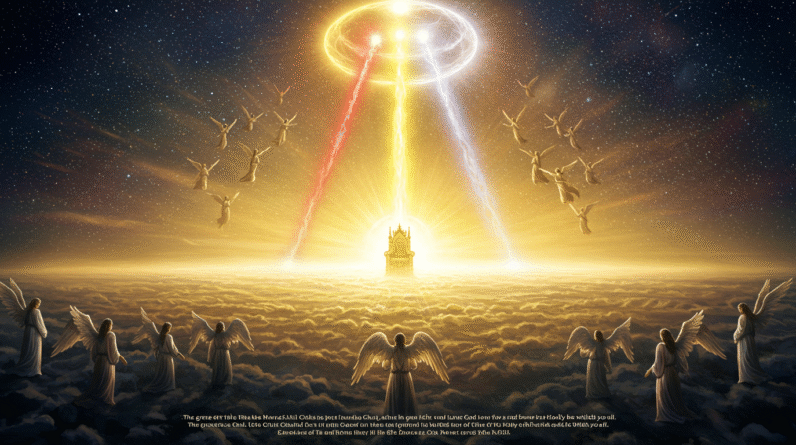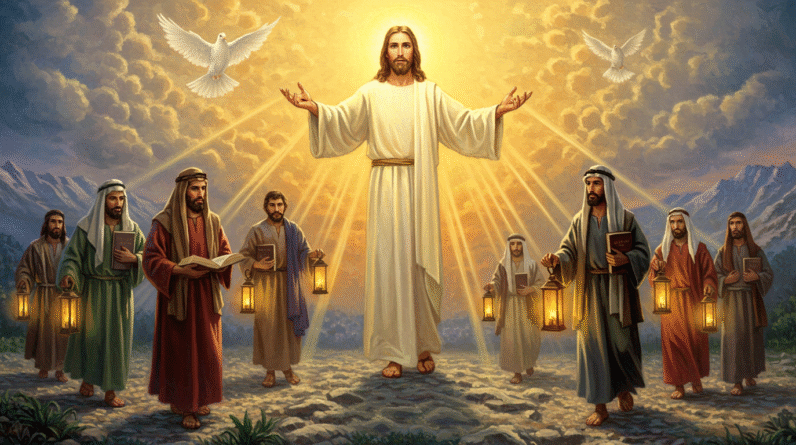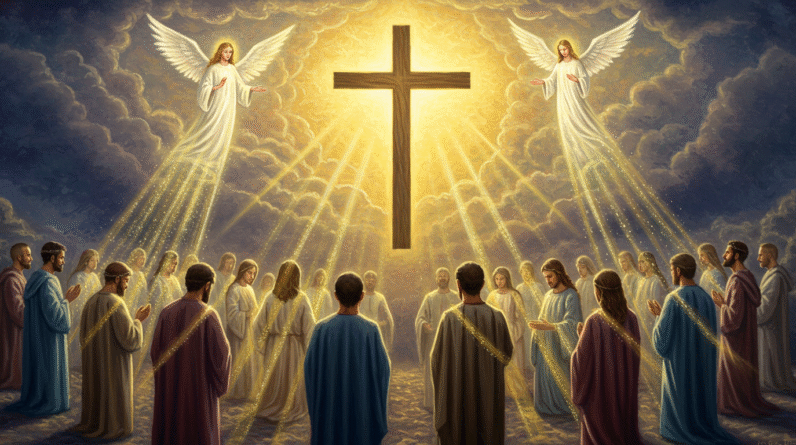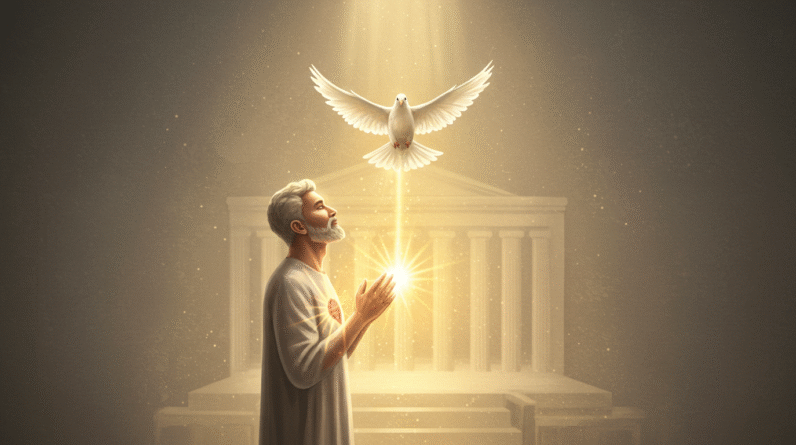The Son Reveals the Father (John 14:9)
When you sit with the words of Jesus in John 14, you stand at one of the clearest windows the New Testament opens onto the heart of God. Jesus says to Philip, “Whoever has seen me has seen the Father” (John 14:9). Those words will change everything for you if you let them. They call you beyond doctrine into a personal knowledge of God — not an abstract idea of deity, but the living, loving face of the Father revealed in the Son.
You may ask, “How can Jesus say that? What does it mean for my faith and for the doctrine of the Trinity?” These are good questions, and they deserve patient, Scripture-shaped answers. In the paragraphs that follow, you’ll be guided gently through the biblical testimony that the Son reveals the Father, how that revelation fits within the truth that God is one yet exists eternally as Father, Son, and Holy Spirit, and what all this means for your life of prayer, worship, and obedience. You will be invited not merely to understand with your mind, but to know God with your heart.
The moment behind the words
You find Jesus saying these words at the Last Supper, in a room heavy with sorrow and hope. Philip asks Jesus to show them the Father (John 14:8-11), and Jesus answers not by pointing to a theological formula but by pointing to himself. He does not merely speak of doctrine; he offers himself as the revelation. This is a pastoral, personal moment — Jesus comforts his disciples by showing that seeing him is seeing the Father. When you read it, remember that Scripture intends you to encounter the living Lord, not just to collect abstract ideas.
What Jesus meant: seeing and knowing
When Jesus says that seeing him is seeing the Father, he is saying more than that he looks like God. He is saying that everything that rightly belongs to the Father — the Father’s character, will, purposes, and redemptive love — is displayed in him. Jesus embodies the Father’s truth, mercy, justice, and holiness in human flesh. The writer of Hebrews helps you here: Jesus is the “radiance of God’s glory and the exact representation of his being” (Hebrews 1:3). If you want to see who God is, you look at Jesus.
The Bible’s witness: One God in three Persons
You might be struggling with the language: one God in three Persons. That phrase is not a clever invention of later theologians; it is a faithful way of describing what the Bible repeatedly shows. You will find unity of essence — there is one God — and distinct persons — Father, Son, and Holy Spirit — who relate in loving, eternal communion. This is what the Scriptures reveal when read as a whole.
Unity of essence: God is one
From the Old Testament cry “Hear, O Israel: The Lord our God, the Lord is one” to the New Testament confession, Scripture upholds the oneness of God. The early Christian witness still affirms this singularity when it prays to the Father, worships the Son, and receives the Spirit. When Jesus says “I and the Father are one” (John 10:30), he is not collapsing persons but affirming unity in divine nature and purpose. That unity is the bedrock of biblical monotheism.
Distinction of persons: Father, Son, Spirit
Scripture is equally clear that the Father, Son, and Holy Spirit are distinct persons who relate to one another. Jesus prays to the Father, the Father sends the Son, and the Spirit intercedes for believers. Jesus promised another Advocate, the Holy Spirit, whom the Father would send in Jesus’ name (John 14:16–17). These are real relationships, not mere modes or manifestations. Jesus speaks with the Father, yet he speaks as someone who is personally distinct from the Father. You see distinction, then, in the life of the triune God.
The Son reveals the Father in Scripture
When you study the New Testament, you see a steady, clear pattern: Jesus reveals the Father simply by being who he is. He is the visible image of the invisible God, the Word made flesh (John 1:14). He displays the Father’s glory, speaks the Father’s words, and fulfills the Father’s will. This is not a peripheral claim; it is central to the Christian gospel.
Jesus as the Word and image of God
The prologue of John places before you the cosmic, creative, and incarnate Son: “In the beginning was the Word, and the Word was with God, and the Word was God” (John 1:1–3). That same Word became flesh and lived among you (John 1:14), so when you look at Jesus you see the purposes and power of the one who made the world. Paul says Christ is “the image of the invisible God” (Colossians 1:15); Hebrews says he is the “exact representation” of God’s being (Hebrews 1:3). You are invited to trust these testimonies and to let them shape your understanding.
Jesus reveals the Father in words and works
Every teaching of Jesus, every act of compassion, and every miracle is a lens through which you can see the Father. When Jesus says, “I do nothing on my own but speak just what the Father has taught me” (John 8:28), he is revealing that his earthly ministry is the Father’s ministry. When he feeds the hungry, heals the sick, and forgives sinners, you witness the Father’s heart in action. If you want to know God’s priorities — mercy, truth, righteousness, sacrificial love — observe Jesus.
The Son’s deity: Scripture declares him God
It is not enough to say Jesus reveals the Father; Scripture also declares that the Son is fully divine. The early church recognized that the Jesus you meet in the Gospels is not merely a great teacher or prophet; he is God incarnate. The New Testament gives you multiple confirmations of the Son’s deity.
Explicit New Testament attestations
John opens with the remarkable claim that the Word was God (John 1:1) and that through him all things were made (John 1:3). Colossians speaks of Christ as the one “in whom all things hold together” and the one “in whom the fullness of deity lives in bodily form” (Colossians 1:17; Colossians 2:9; https://www.biblegateway.com/passage/?search=Colossians+2:9&version=NIV). Hebrews says he is the “radiance of God’s glory” and “the exact representation of his being” (Hebrews 1:3). If you wonder whether the early church saw Jesus as God, these passages give you a clear answer.
Old Testament foreshadowing
The Old Testament also prepares you for a divine agent in the world who will reveal God’s presence and reign. Prophecies like Isaiah’s promise of a child called “Mighty God” and “Everlasting Father” (Isaiah 9:6) point you toward a unique person who will display God’s rule. You are not left to discover this in isolation; Scripture builds a consistent witness across both Testaments.
The Spirit’s deity: the third person is also God
If you read the New Testament carefully, you will find that the Holy Spirit is not a vague force but a personal, divine person. The Spirit comforts, teaches, convicts, and empowers. The New Testament treats the Spirit with the same divine honors given to the Father and the Son.
Biblical indicators of the Spirit’s deity
When Ananias lies to the Holy Spirit, Peter says he has lied not to men but to God (Acts 5:3–4). That is a startling and sobering statement: the Holy Spirit is God. Jesus promised the Father would send the Spirit, whom he called the Spirit of truth (John 14:16–17), and the Spirit is described as dwelling within believers (Romans 8:9). These passages show you the Spirit’s personhood, presence, and divinity.
The Trinity in practice: baptism and blessing
You will see the triune life of God reflected in the life of the Church. Jesus gave you a baptismal formula that places Father, Son, and Holy Spirit together as the one God to whom you belong, and Paul prays using all three persons to bless the church.
Baptism in the name of the Trinity
Jesus commanded his disciples to baptize “in the name of the Father and of the Son and of the Holy Spirit” (Matthew 28:19). That command shows the Church how to enter people into the life of the triune God. When you are baptized in that name, you are not simply enacting a ritual; you are being brought into the covenantal reality of God who is Father, Son, and Holy Spirit.
The apostolic blessing
Paul’s benediction at the close of 2 Corinthians gives you a beautiful, lived expression of the Trinity: “May the grace of the Lord Jesus Christ, and the love of God, and the fellowship of the Holy Spirit be with you all” (2 Corinthians 13:14). In one short line the apostle offers you the grace of Jesus, the love of the Father, and the fellowship of the Spirit — three divine realities working together for your good.

How the Son reveals the Father in Jesus’ life
To see the Father in the Son, you need to watch carefully how Jesus lived. His life is the clearest exposition of God’s character you will ever meet. Jesus modeled prayer, dependence, compassion, holiness, and sacrificial love — all the traits of the Father’s heart.
Compassion and mercy
You cannot read the Gospels without encountering Jesus’ compassion for the poor, the sick, the outcast, and the sinful. The Father’s heart is a heart of mercy, and Jesus embodies that mercy as he heals the sick, eats with tax collectors, and forgives sinners. Consider the raising of Lazarus, where Jesus weeps with those who mourn (John 11:33–35); here you see the Father’s love in the Son’s tears and power.
Obedience and sacrificial love
Jesus’ obedience to the Father culminates on the cross. His willingness to lay down his life shows you the Father’s redemptive purpose. Jesus says he came “not to be served but to serve, and to give his life as a ransom for many” (Matthew 20:28). Through the cross you see the depth of the Father’s resolve to redeem a fallen world, and the Son’s full participation in that plan.
Teaching and revelation
All of Jesus’ teaching flows from the Father. When he tells you to pray, he teaches you to address God as Father (Matthew 6:9). When he speaks about God’s will, he speaks as one who knows it intimately. In Jesus’ parables and sermons you get a portrait of the Father’s desires — for repentance, for the lost to be found, for the Kingdom to come.
What John 14:9 means for your life today
When Jesus tells Philip that seeing him is seeing the Father, he is inviting you into relationship. The doctrine of the Trinity is not a theological trophy to be polished but a pastoral reality that shapes how you pray, how you worship, and how you live.
Prayer through the Son to the Father
Because the Son reveals the Father, you always come to the Father through the Son. Jesus said, “I am the way and the truth and the life. No one comes to the Father except through me” (John 14:6). That is both a comfort and a claim. You can approach God with confidence because Christ has opened the way. Your prayers are heard because the Son intercedes for you.
Worship that sees God’s face
When you worship Christ, you are not worshiping someone less than God. You are worshiping the Son who reveals the Father. Worship thus becomes a response to the God who has drawn near in Christ. The Psalms, the Gospels, and the New Testament letters all call you to worship the triune God who is worthy.
Transformation by the Spirit
Seeing the Father in the Son is not merely intellectual; it changes you. The Holy Spirit, sent by the Father in the name of the Son, works in you to conform you to Christ’s image. The Spirit empowers your obedience, guides your conscience, and assures you of God’s presence (John 14:16–17; Romans 8:9). As the Son reveals the Father, the Spirit brings that revelation to your heart so you become more like what you see.
How to study the Trinity through Scripture
You may want to dig into this truth for yourself. That is a noble desire. Studying the Trinity is not merely academic work; it is a spiritual discipline that will draw you nearer to God if you pursue it with humility and prayer.
- Begin with the Gospels, especially John, and let Jesus’ words lead you to the Father.
- Read passages that speak of Jesus’ deity and the Spirit’s personhood in their wider biblical contexts — passages like John 1:1–14, Colossians 2:9, Hebrews 1:3, and Acts 5:3–4.
- Use trusted resources like Bible Gateway to compare translations, and consult faithful commentaries and the creeds (for historical reflection) with a heart open to being changed.
If you want a starting reading plan, take John, Colossians, Hebrews, and Romans in that order. Pray as you read and ask the Father, through the Son, by the Spirit, to open your eyes.
Common questions you might have
You will likely wrestle with questions as you study. That’s part of growing in faith. Let Scripture answer gently, and don’t be afraid to ask a pastor or a mature believer to walk with you.
What about the word “Trinity”? The exact word isn’t in the Bible, but the reality is. Scripture gives you the facts: Father, Son, and Holy Spirit are each revealed as God and as distinct persons. The church summarized that reality in the term “Trinity” to help you hold both truths together.
How can God be one and yet three? Scripture calls you to a mystery — not a contradiction. Think of it this way: God is one in essence, yet within that one essence are three eternal Persons who relate in love. It’s not a full explanation (no simple human analogy will do), but it’s the faithful way the Bible talks about God’s inner life.
Does this matter for salvation? It matters everything. The Father’s love brought you a Savior; the Son’s atoning work brings you forgiveness; the Spirit’s presence brings you life. Deny any person of the Trinity and you lose aspects of the gospel. The triune God is the God who saves.
Living in light of the Son’s revelation of the Father
If you allow Jesus to reveal the Father to you, your life will become a reflection of that revelation. You will worship more, fear less, love more, and serve sacrificially. You will pray with confidence, knowing that the Father hears you because the Son intercedes and the Spirit aids your weakness (Romans 8:26).
A few practical changes you’ll likely see
You will find your prayers becoming simpler and more direct — addressing the Father but relying on the Son and empowered by the Spirit. Your worship will center on praise for what God has done in Christ, and your life will bear the fruit of the Spirit: love, joy, peace, patience, kindness, goodness, faithfulness, gentleness, and self-control (Galatians 5:22–23). You will also be drawn into mission — the Father sends, the Son redeems, the Spirit equips.
A pastoral word: meet the Father through the Son
If you are struggling with sin, doubt, loneliness, or fear, let me say plainly: the Father you see in Jesus is not distant or harsh. He is loving, patient, and ready to forgive. Jesus stands as the perfect representation of that Father. Come to him. Look to him. In his wounds you find healing; in his resurrection you find life. The early followers of Jesus did not merely debate doctrine — they knelt before the risen Lord and were transformed. You can be transformed too.
Closing encouragement
As you go from this study, take John 14:9 with you: the Son reveals the Father. Let the words sink in slowly and lovingly. Read the passages that show the Son’s deity and the Spirit’s personhood. Pray: “Lord Jesus, help me to see the Father in you. Send your Spirit to make that sight real in my heart.” The triune God is not a distant mystery but a living reality that invites you into fellowship today.
Explore More
For further reading and encouragement, check out these posts:
👉 7 Bible Verses About Faith in Hard Times
👉 Job’s Faith: What We Can Learn From His Trials
👉 How To Trust God When Everything Falls Apart
👉 Why God Allows Suffering – A Biblical Perspective
👉 Faith Over Fear: How To Stand Strong In Uncertain Seasons
👉 How To Encourage Someone Struggling With Their Faith
👉 5 Prayers for Strength When You’re Feeling Weak

📘 Jesus and the Woman Caught in Adultery – Grace and Mercy Over Judgement
A powerful retelling of John 8:1-11. This book brings to life the depth of forgiveness, mercy, and God’s unwavering love.
👉 Check it now on Amazon
As a ClickBank & Amazon Affiliate, I earn from qualifying purchases.
Acknowledgment: All Bible verses referenced in this article were accessed via Bible Gateway (or Bible Hub).
“Want to explore more? Check out our latest post on Why Jesus? and discover the life-changing truth of the Gospel!”








